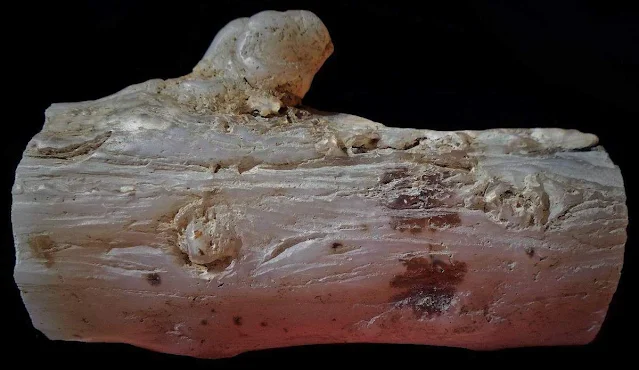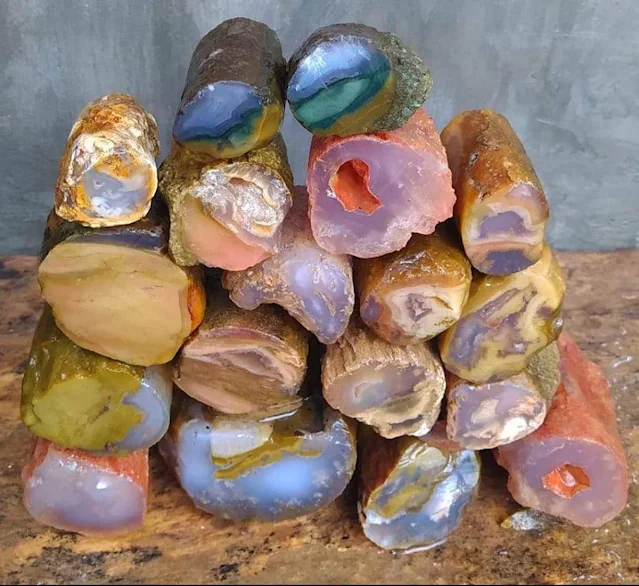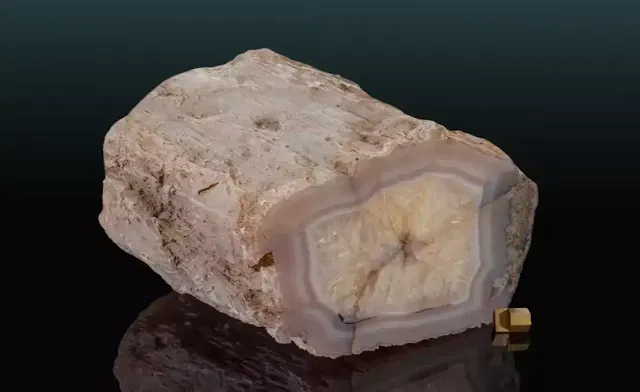Limb Cast: From Wood to Gems
The transformation from wood to opal or agate gems through fossilization is a fascinating geological process.
What is Limb Cast?
Limb cast is a type of fossil formed when a tree branch decomposes and leaves a cavity, which is then filled with minerals, typically chalcedony, agate, or silica (opal). This process essentially creates a stone replica of the original branch, preserving its external shape and features like bark texture and branch form, but not the internal wood structure.
Limb cast refers to a pseudomorph, which is a mineral that replaces the original material of an object while preserving its shape and external features, in this case, a tree branch. They are formed when a tree branch gets buried by volcanic ash, which burns away the organic material leaving a hollow space. This space is then filled with mineral-rich groundwater that crystallizes over time, forming a solid cast that resembles the original branch.
 |
| Limb Cast: From Wood to Opal or Agate Gems |
Formation: How are limb casts formed?
1-Burial by Volcanic Ash: A tree branch gets buried by volcanic ash, either during an eruption or through subsequent sedimentation processes. The hot ash, often containing high temperatures, acts somewhat like a natural furnace.
2. Decomposition of Wood: The heat from the ash gradually burns away the organic material of the branch. This process leaves behind a hollow space or mold that perfectly captures the original shape and details of the branch, including its bark and wood grain textures.
3. Mineralization: Over time, mineral-rich water (groundwater) seeps into the empty space left behind by the decomposed wood. This water is often rich in minerals like silica, which can form various quartz minerals, including chalcedony, a common component of limb casts.
4. Crystallization: As the mineral-rich water fills the mold, the dissolved minerals begin to crystallize. This process gradually solidifies the minerals, transforming the liquid solution into a solid cast that replicates the exact shape of the original branch, hence the name "limb cast."
5. Unveiling the Cast: Eventually, through erosion or other geological processes, the surrounding rock or ash may be weathered away, revealing the hardened mineral cast of the ancient branch. This exposed cast is what we now recognize as a "limb cast."
 |
| Agate Limb Cast from John Day Formation, Congleton Hollow, near Post/Paulina, Crook County, Oregon. Photo: LGF Foundation, Inc. |
Types of Limb Casts
Silicified Limb Casts: In some cases, the original plant material is replaced by silica during the mineralization process. This can result in silicified limb casts, where the structure of the limb is preserved by the infiltration and hardening of silica minerals. They are often white, gray, or brown in color and can have a smooth or a slightly rough texture.
Agatized Limb Casts: Limb casts can undergo agatization, where the original plant material is replaced by agate, a form of chalcedony composed of microcrystalline quartz. Agatized limb casts often exhibit beautiful patterns and colors.
Opalized Limb Casts: These are limb casts where the replacing mineral is opal, a hydrated form of silica result in opalization, where the limb cast is composed of opal. Opal casts can be quite beautiful, with a milky white or translucent appearance and sometimes exhibiting a play of color.
Jasper casts: These are limb casts where the replacing mineral is jasper, a type of chalcedony with a more opaque and colorful appearance. Jasper casts can be red, yellow, green, or brown, and they often have a more polished look than chalcedony casts.
Pyritized Limb Casts: In these casts, the replacing mineral is pyrite, also known as fool's gold. They have a distinctive metallic golden yellow color and often lack the fine details of the original wood compared to silicified casts.
 |
| Agate limb casts. Photo: Andri Saputra |
Where are limb casts found?
Limb casts are often found in areas with volcanic activity, such as near ancient volcanoes or in sedimentary rocks that were once deposited in volcanic environments. They can be various colors, including brown, red, green, and purple, depending on the minerals present during their formation.
Limb casts are primarily found in specific locations where the geological conditions for their formation exist. Some notable areas include:
Central Oregon, USA: This region, particularly the area around Congleton Hollow and Dendrite Butte, is famous for its pink and green limb casts. These formed in the Clarno Formation, a deposit of volcanic ash and debris flow that buried and preserved ancient forests.
Wyoming, USA: The Petrified Forest National Park in Wyoming is another prominent location where limb casts can be found. These casts are typically brown or gray in color and formed in a similar way to those in Oregon.
Argentina: Limb casts are also found in Patagonia, Argentina, where they have formed in volcanic ash deposits similar to those in Oregon and Wyoming.
Ethiopia: Primarily known for its opal limb casts, found in the Welo region. These casts are prized for their unique play of color.
Other locations: Limb casts can also be found in Australia, New Zealand, and Madagascar.
 |
| Opal Limb Cast-from Tsehey Mewcha, Wegeltena, Wollo Province, Ethiopia. Photo: LGF Foundation, Inc. |
Limb cast Vs. Petrified Wood
While both limb casts and petrified wood are fossilized remnants of ancient trees, Limb Cast: Starts with a cavity left behind after a tree branch decomposes. This cavity can be formed by various means, including volcanic ash filling the space left by a burned branch or sediment filling the space after the wood decays. Petrified Wood: Starts with the actual wood of a tree branch or trunk.
In simpler terms, a limb cast is like a mold of the original branch, while petrified wood is the original wood turned to stone. Limb casts capture the shape, while petrified wood preserves the actual substance of the wood.
 |
| Opal Limb Cast from Wollo Province, Ethiopia. |
 |
| Limb Cast agate - Clarno Formation, Congalton Hollow, Crook County, Oregon, USA |
These gemstone limb casts are not only scientifically interesting but also have aesthetic value, making them sought after by collectors and enthusiasts. If you're writing an article or content related to these limb cast types, you can explore their geological formation, characteristics, and the appeal they hold in both scientific and artistic contexts.
Read also:
Opalized Wood: Gemstone, Formation, Where to Find it
Agatized Wood: Gemstone, Value, Uses
Turritella Agate: Fossilized Snail Gemstone








